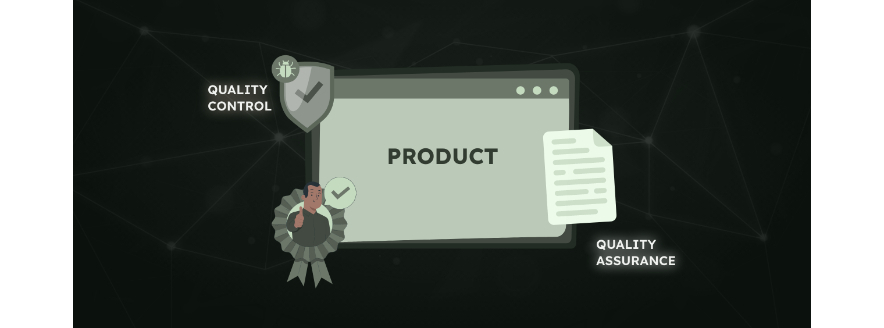Quality Control Vs. Quality Assurance: Highlighting The Differences

In the world of software development, quality assurance and quality control are often used interchangeably. However, these concepts are unique components of the software development life cycle. Understanding the subtle but crucial differences between these two concepts is essential for building robust software solutions.
Quality is the backbone of the development process. Putting low-quality software in the hands of end users leads to numerous problems, including failing to meet customer requirements and damaging the brand’s reputation.
Quality Management: The Overarching Framework
Quality management (QM) is a combination of QA and QC. This approach helps enhance both product and service quality at a company-wide level. Embedding quality in organizational culture, QM helps teams align quality processes, policies, and objectives with the organization’s goals and direction, all while enforcing adherence to quality standards.
Quality Control (QC): Definition & Overview
Quality control focuses on identifying defects and errors in the final product. It involves activities performed during or after the development phase to ensure that the software meets specified requirements and standards. QC is primarily reactive, as it deals with detecting and rectifying issues once they arise.
Key Components of Quality Control:
Testing: QC involves rigorous testing processes, including functional testing, performance testing, usability testing, regression testing, among others. These tests aim to uncover bugs and deviations from expected behavior.
Inspection: Through meticulous examination of code, design, and documentation, QC aims to pinpoint inconsistencies, ambiguities, or non-compliance with defined standards.
Debugging: Post identifying defects, QC teams engage in debugging activities to isolate and rectify the root cause of the issues, ensuring the software functions as intended.
Tools & Techniques
Testing categories include manual testing which requires human involvement and is often highly detailed); automated testing which is aimed at improving speed and consistency and requires tests to be scripted; and regression testing, which is usually automated and ensures that new changes do not adversely affect existing functionalities.
Quality Assurance (QA): Definition & Overview
Quality assurance, on the other hand, is a proactive approach aimed at preventing defects from occurring in the first place. QA focuses on the entire software development process rather than just the end product. It emphasizes building quality into every phase of the development lifecycle, from planning and design to coding and deployment.
Key Components of Quality Assurance:
Process Improvement: QA involves continuously refining development processes to enhance efficiency and effectiveness. This includes defining standards, implementing best practices, and fostering a culture of quality within the organization.
Requirement Analysis: QA teams work closely with stakeholders to ensure comprehensive understanding and documentation of requirements. Clear and unambiguous requirements reduce the likelihood of misunderstandings and errors during development.
Quality Planning: QA encompasses strategic planning to establish quality objectives, metrics, and processes tailored to the specific needs of each project. It involves risk assessment, resource allocation, and scheduling to ensure smooth execution.
Tools & Techniques
To make the QA process more efficient, QA professionals employ a variety of tools and techniques to maintain software excellence, quality, and reliability. TestRail, for example, makes managing and tracking test cases easier and more effective. Selenium, a well-known name in the testing world, helps QA teams automate their testing for quality.
Emphasizing the Differences
While both QC and QA are essential components of software quality management, they operate at different stages of the development lifecycle and serve distinct purposes.
| Quality Control | Quality Assurance |
|---|---|
| QC focuses on detecting and correcting defects in the final product | QA concentrates on preventing defects through process improvement and proactive measures. |
| QC activities occur during or after development. |
QA activities are integrated throughout the entire development process, starting from project initiation. |
| QC is typically the responsibility of testing teams | QA involves collaboration across various roles, including developers, testers, project managers, and stakeholders. |
Conclusion:
In essence, both QC and QA are indispensable components of software quality management, working in tandem to deliver reliable and high-performing software solutions. Understanding the distinctions between these two concepts is crucial to organizations striving to achieve excellence in software development. By embracing both QC and QA practices, businesses can foster a culture of quality, mitigate risks, and deliver superior products that meet or exceed customer expectations.



LEAVE A COMMENT